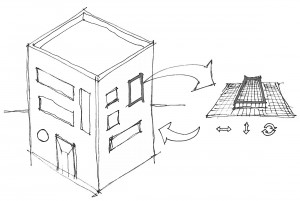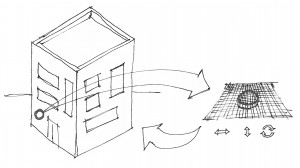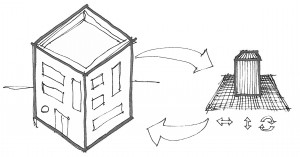Shape Displays already demonstrate an incredible ability to perform simple digital modeling, parameter control, model display, etc. These examples, while impressive, suffer from an inherent (and potentially insurmountable) set of physical limits, among them scale and axis restriction. The display is bound by limited resolution, and cannot model voids with ceilings, or surfaces that cantilever.
Architectural models, on the other hand, are moving towards ever-increasing levels of resolution. BIM is resulting in the digital representation of almost every single building component, down to the hardware (and even at early stages of design).
Thus, I propose adapting shape displays to a new end – one that mediates between virtual display and physical interaction, BIM model and architectural designer, two-dimensional representations and three. Shape displays will take the form of a simple, primitive shape. This shape can be molded, stretched, skewed, etc. These basic transformations will then be correlated with a connected digital model. The user will isolate a portion of the model to manipulate (or choose the entire model), and then use the shape display to perform simple transformations. In this way the user can interact directly (i.e., tangibly) with the digital model, whether he or she is manipulating one-, two-, or three-dimensional constraints. Once the transformation is complete, the shape display re-sets back to its primitive form (or a different one – whichever the user chooses).
In the end, the digital model is allowed to be as detailed as it needs to be, unbound by the resolution restriction of the interface. The interface makes possible a tangible manifestation of the simple modeling transformations that designers currently perform through clicks and menu options. The interface and the model can connect, but are not bound to one another.
Alternatively, once the discrete model element is chosen, the parameter clay could project a simplified version of this form, upon which the user would then act.



